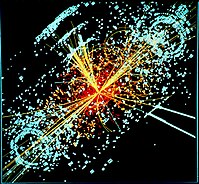
Photo from wikipedia
A major source of uncertainty in proton therapy is the conversion of Hounsfield unit (HU) to proton stopping power ratio relative to water (SPR). In this study, we measured and… Click to show full abstract
A major source of uncertainty in proton therapy is the conversion of Hounsfield unit (HU) to proton stopping power ratio relative to water (SPR). In this study, we measured and quantified the accuracy of a stoichiometric dual energy CT (DECT) SPR calibration. We applied a stoichiometric DECT calibration method to derive the SPR using CT images acquired sequentially at [Formula: see text] and [Formula: see text]. The dual energy index was derived based on the HUs of the paired spectral images and used to calculate the effective atomic number (Z eff), relative electron density ([Formula: see text]), and SPRs of phantom and biological materials. Two methods were used to verify the derived SPRs. The first method measured the sample's water equivalent thicknesses to deduce the SPRs using a multi-layer ion chamber (MLIC) device. The second method utilized Gafchromic EBT3 film to directly compare relative ranges between sample and water after proton pencil beam irradiation. Ex vivo validation was performed using five different types of frozen animal tissues with the MLIC and three types of fresh animal tissues using film. In addition, the residual ranges recorded on the film were used to compare with those from the treatment planning system using both DECT and SECT derived SPRs. Bland-Altman analysis indicates that the differences between DECT and SPR measurement of tissue surrogates, frozen and fresh animal tissues has a mean of 0.07% and standard deviation of 0.58% compared to 0.55% and 1.94% respectively for single energy CT (SECT) and SPR measurement. Our ex vivo study indicates that the stoichiometric DECT SPR calibration method has the potential to be more accurate than SECT calibration under ideal conditions although beam hardening effects and other image artifacts may increase this uncertainty.
Journal Title: Physics in medicine and biology
Year Published: 2018
Link to full text (if available)
Share on Social Media: Sign Up to like & get
recommendations!